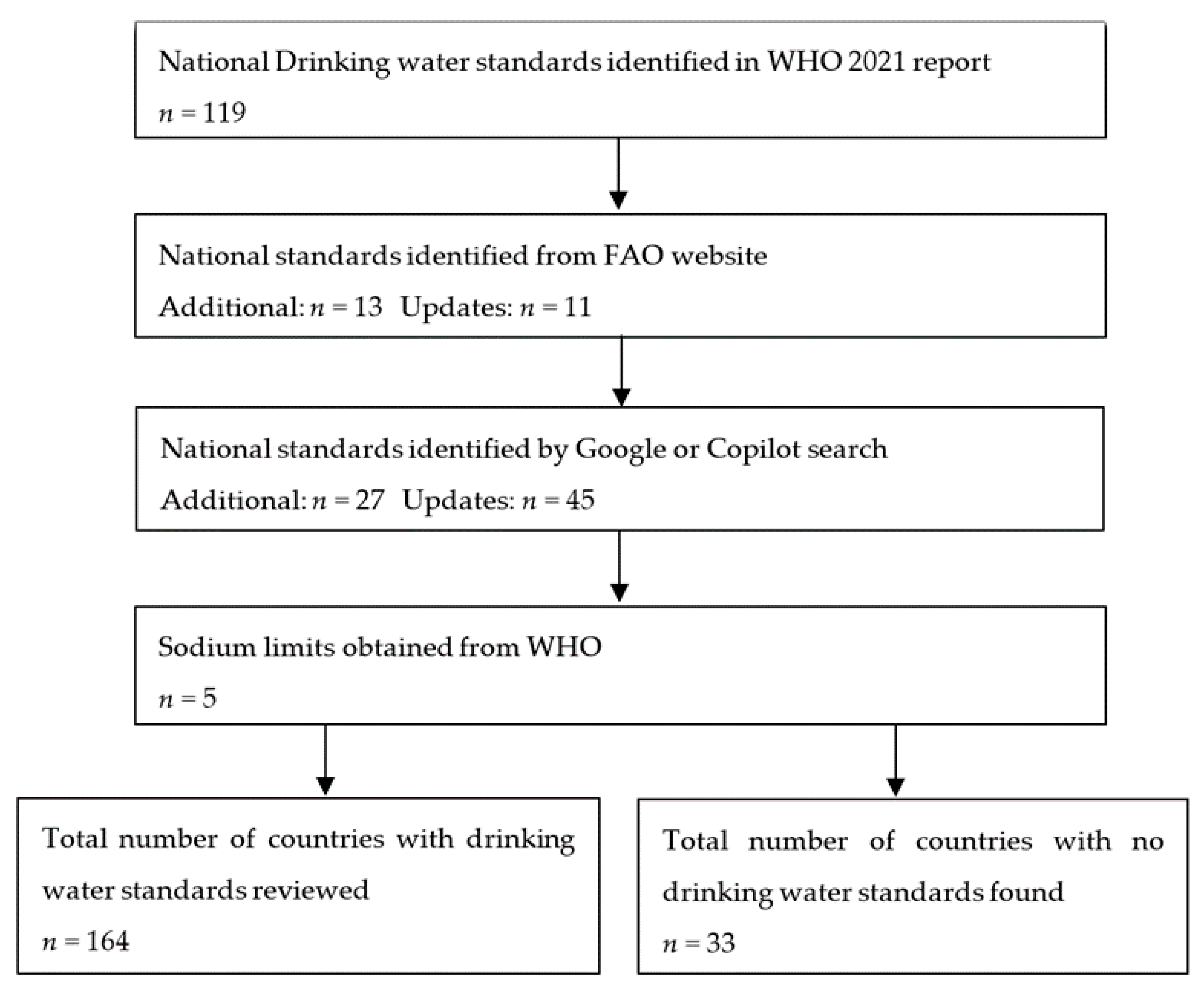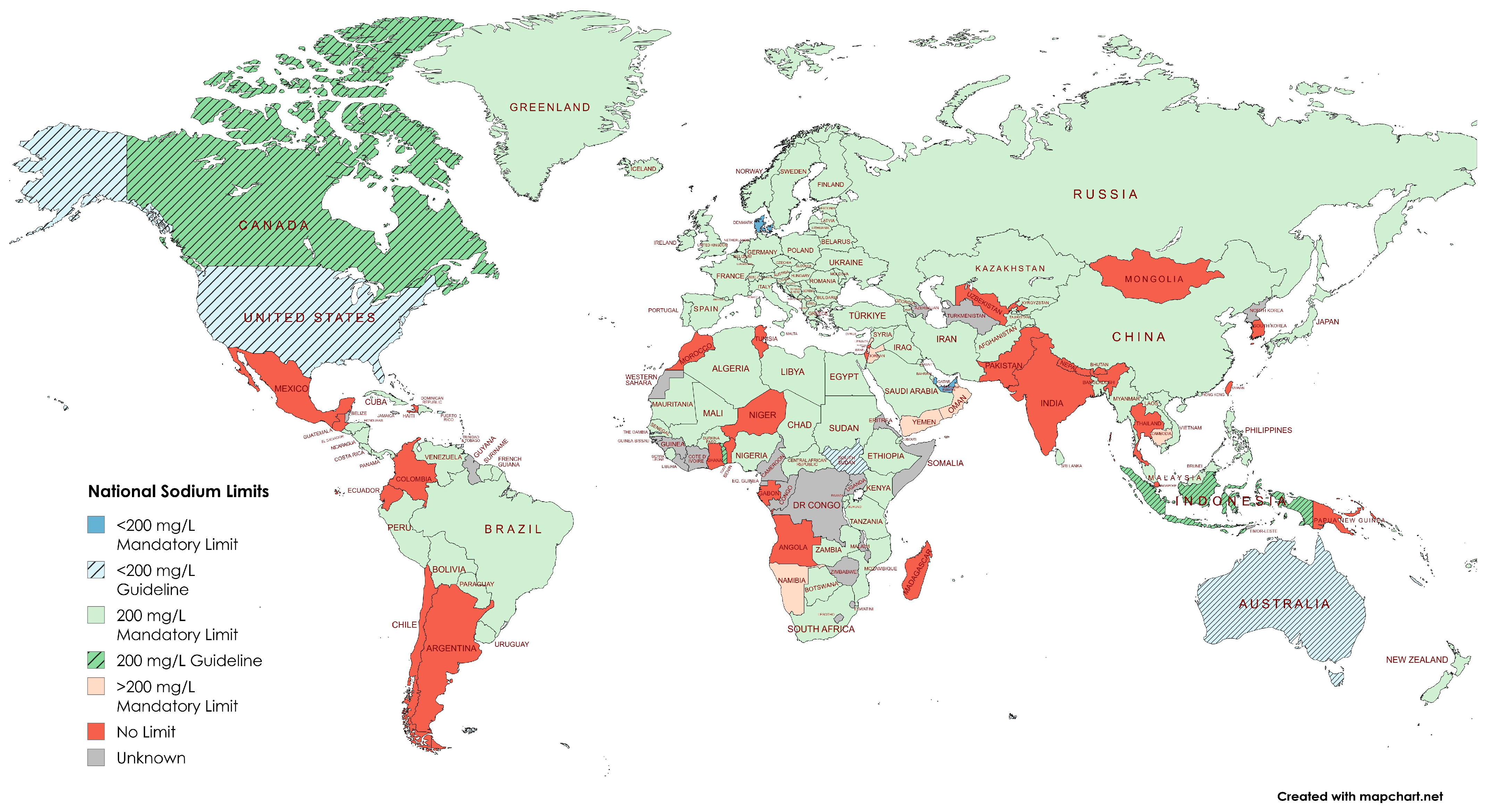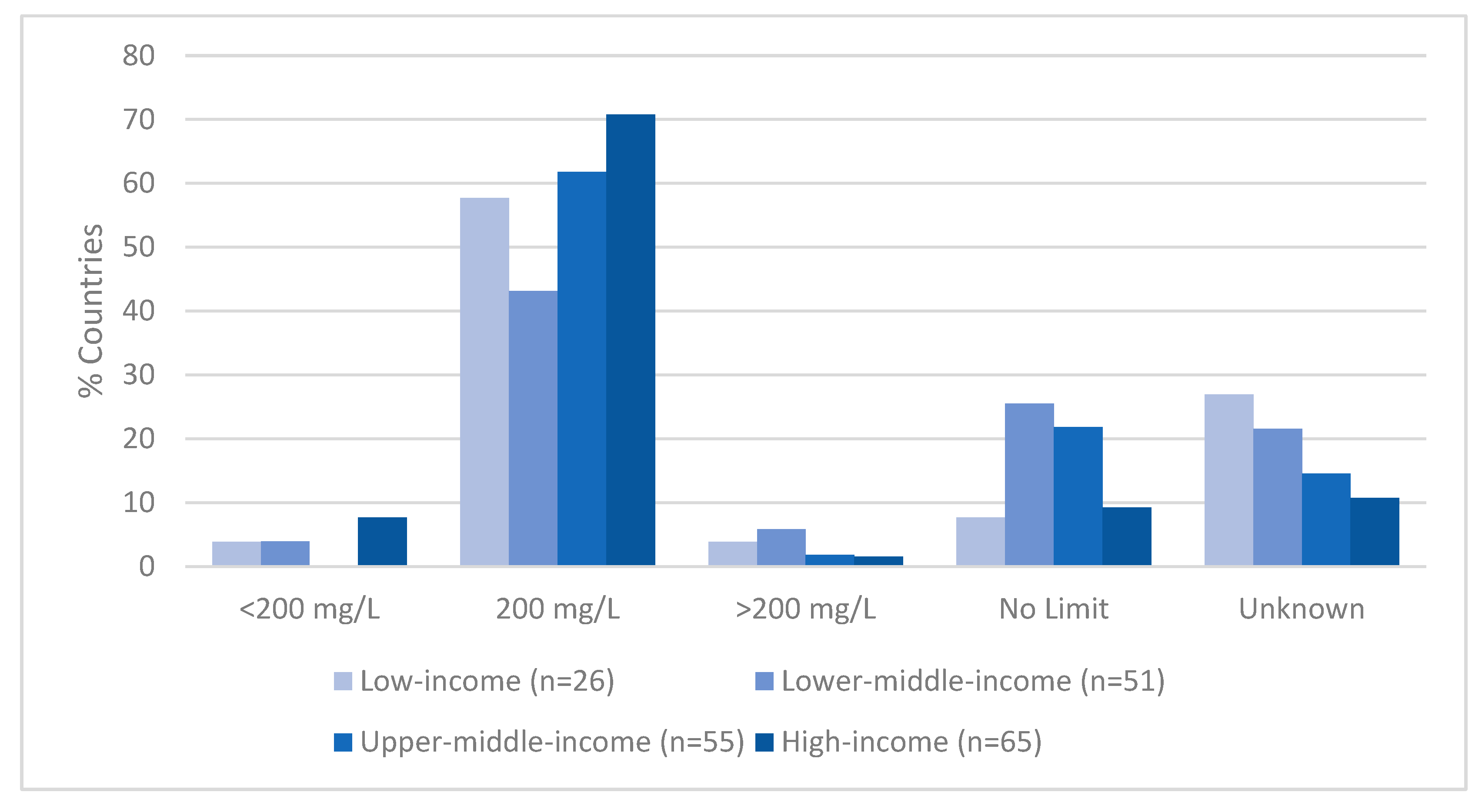Global Drinking Water Standards Lack Clear Health-Based Limits for Sodium
Abstract
1. Introduction
Definitions
2. Materials and Methods
3. Results
4. Discussion
5. Conclusions
Supplementary Materials
Author Contributions
Funding
Institutional Review Board Statement
Informed Consent Statement
Data Availability Statement
Acknowledgments
Conflicts of Interest
Abbreviations
| WHO | World Health Organization |
| GDWQ | Guidelines for Drinking Water Quality |
References
- Institute for Health Metrics and Evaluation. Global Burden of Disease (GBD) Study 2021; Institute for Health Metrics and Evaluation: Seattle, WA, USA, 2021. [Google Scholar]
- World Health Organization. Guideline: Sodium Intake for Adults and Children; World Health Organization: Geneva, Switzerland, 2012. [Google Scholar]
- World Health Organization. WHO Global Report on Sodium Intake Reduction; World Health Organization: Geneva, Switzerland, 2023. [Google Scholar]
- World Health Organization (WHO). Sodium in Drinking-Water. Background Document for Development of WHO Guidelines for Drinking-Water Quality; WHO: Geneva, Switzerland, 2003. [Google Scholar]
- Talukder, M.R.; Rutherford, S.; Huang, C.; Phung, D.; Islam, M.Z.; Chu, C. Drinking water salinity and risk of hypertension: A systematic review and meta-analysis. Arch. Environ. Occup. Health 2017, 72, 126–138. [Google Scholar] [CrossRef] [PubMed]
- Al Nahian, M.; Ahmed, A.; Lázár, A.N.; Hutton, C.W.; Salehin, M.; Streatfield, P.K. Drinking water salinity associated health crisis in coastal Bangladesh. Elem. Sci. Anthr. 2018, 6, 2. [Google Scholar] [CrossRef]
- Xeni, C.; Oliva, R.; Jahan, F.; Romaina, I.; Naser, A.M.; Rahman, M.; Fleming, L.E.; Gribble, M.O.; Makris, K.C. Epidemiological evidence on drinking water salinity and blood pressure: A scoping review. Environ. Res. Health 2023, 1, 035006. [Google Scholar] [CrossRef]
- Pomeranz, A.; Dolfin, T.; Korzets, Z.; Eliakim, A.; Wolach, B. Increased sodium concentrations in drinking water increase blood pressure in neonates. J. Hypertens. 2002, 20, 203–207. [Google Scholar] [CrossRef]
- Calabrese, E.J.; Tuthill, R.W. The Massachusetts Blood Pressure Study, Part 1. Elevated levels of sodium in drinking water and blood pressure levels in children. Toxicol. Ind. Health 1985, 1, 1–10. [Google Scholar] [CrossRef] [PubMed]
- Calabrese, E.J.; Tuthill, R.W. The Massachusetts Blood Pressure Study, Part 3. Experimental reduction of sodium in drinking water: Effects on blood pressure. Toxicol. Ind. Health 1985, 1, 19–34. [Google Scholar] [CrossRef]
- Calabrese, E.J.; Tuthill, R.W. The influence of elevated levels of sodium in drinking water on elementary and high school students in Massachusetts. Sci. Total Environ. 1981, 18, 117–133. [Google Scholar] [CrossRef]
- Khan, A.E.; Scheelbeek, P.F.; Shilpi, A.B.; Chan, Q.; Mojumder, S.K.; Rahman, A.; Haines, A.; Vineis, P. Salinity in drinking water and the risk of (pre)eclampsia and gestational hypertension in coastal Bangladesh: A case-control study. PLoS ONE 2014, 9, e108715. [Google Scholar] [CrossRef]
- Khan, A.E.; Ireson, A.; Kovats, S.; Mojumder, S.K.; Khusru, A.; Rahman, A.; Vineis, P. Drinking Water Salinity and Maternal Health in Coastal Bangladesh: Implications of Climate Change. Environ. Health Perspect. 2011, 119, 1328–1332. [Google Scholar] [CrossRef]
- Dasgupta, S.; Huq, M.; Wheeler, D. Drinking Water Salinity and Infant Mortality in Coastal Bangladesh. Water Econ. Policy 2016, 2, 1650003. [Google Scholar] [CrossRef]
- Akter, S. Impact of drinking water salinity on children’s education: Empirical evidence from coastal Bangladesh. Sci. Total Environ. 2019, 690, 1331–1341. [Google Scholar] [CrossRef] [PubMed]
- Chakraborty, R.; Khan, K.M.; Dibaba, D.T.; Khan, M.A.; Ahmed, A.; Islam, M.Z. Health Implications of Drinking Water Salinity in Coastal Areas of Bangladesh. Int. J. Environ. Res. Public Health 2019, 16, 3746. [Google Scholar] [CrossRef] [PubMed]
- Rosinger, A.Y.; Bethancourt, H.; Swanson, Z.S.; Nzunza, R.; Saunders, J.; Dhanasekar, S.; Kenney, W.L.; Hu, K.; Douglass, M.J.; Ndiema, E.; et al. Drinking water salinity is associated with hypertension and hyperdilute urine among Daasanach pastoralists in Northern Kenya. Sci. Total Environ. 2021, 770, 144667. [Google Scholar] [CrossRef]
- Vineis, P.; Chan, Q.; Khan, A.E. Climate change impacts on water salinity and health. J. Epidemiol. Glob. Health 2011, 1, 5–10. [Google Scholar] [CrossRef] [PubMed]
- Jeske, T.B.; Reginato, P. Evaluation of the sodium concentration in the groundwater of the Aquifier Systems of the State of Rio Grande do Sul, Brazil. Res. Sq. 2022; [Pre-print]. [Google Scholar] [CrossRef]
- Chen, J.; Huang, Q.; Lin, Y.; Fang, Y.; Qian, H.; Liu, R.; Ma, H. Hydrogeochemical Characteristics and Quality Assessment of Groundwater in an Irrigated Region, Northwest China. Water 2019, 11, 96. [Google Scholar] [CrossRef]
- Su, G.; Liu, G.; Li, Y.; Wang, G. Analysis of groundwater ion abnormality and its cause of centralized drinking water sources in Jieshou City, China. Front. Environ. Sci. 2023, 10, 1055623. [Google Scholar] [CrossRef]
- Azara, A.; Castiglia, P.; Piana, A.; Masia, M.D.; Palmieri, A.; Arru, B.; Maida, G.; Dettori, M. Derogation from drinking water quality standards in Italy according to the European Directive 98/83/EC and the Legislative Decree 31/2001—A look at the recent past. Ann. Ig. 2018, 30, 517–526. [Google Scholar]
- United States Environmental Protection Agency. Contaminant Candidate List Regulatory Determination Support Document for Sodium; U.S. Environmental Protection Agency: Washington, DC, USA, 2003. Available online: https://www.epa.gov/sites/default/files/2014-09/documents/support_cc1_sodium_ccl_regdet.pdf (accessed on 6 June 2025).
- Wright, I.A.; Morrison, K.G.; Ryan, M.M.; Cusbert, S.; Reynolds, J.K. Elevated sodium concentrations in Australian drinking water supplies. Earth Environ. Sci. 2019, 344, 012032. [Google Scholar] [CrossRef]
- World Health Organization. A Global Overview of National Regulations and Standards for Drinking Water Quality, 2nd ed.; World Health Organization: Geneva, Switzerland, 2021. [Google Scholar]
- World Health Organization. Guidelines for Drinking-Water Quality; World Health Organization: Geneva, Switzerland, 2017. [Google Scholar]
- Earle, N.; Spencer, W.; McCausland, R.; Futeran, P.; Webster, J.; Leslie, G. Yuwaya Ngarra-li Briefing Paper: Walgett’s Drinking Water; UNSW Sydney: Sydney, NSW, Australia, 2023. [Google Scholar]
- Tonkin, T.; Deane, A.; Trindall, A.; Weatherall, L.; Madden, T.; Moore, B.; Earle, N.; Nathan, M.; Young, S.; McCausland, R.; et al. Yuwaya Ngarra-li Community Briefing Report: Key Findings from the Food and Water Security Surveys in Walgett; UNSW Sydney: Sydney, NSW, Australia, 2023; Available online: https://unsworks.unsw.edu.au/entities/publication/ba43d24e-253e-49f8-ae86-d96be8c6754c (accessed on 6 June 2025).
- Food and Agriculture Organization. FAOLEX Database. Available online: https://www.fao.org/faolex/country-profiles/en/ (accessed on 6 June 2025).
- European Parliament & Council of the European Union. Directive (EU) 2020/2184 on the Quality of Water Intended for Human Consumption; European Union: Brussels, Belgium, 2020. [Google Scholar]
- Ministry of Rural Development (MRD). National Rural Drinking-Water Quality Guidelines; Ministry of Rural Development (MRD): New Delhi, India, 2015.
- Ionics Freshwater Ltd. Spring Garden Desalination Plant, Barbados; Ionics Freshwater Ltd.: St Michael, Barbados, 2025. [Google Scholar]
- Fanack Water. Water Infrastructure in Qatar; Fanack Water: The Hague, The Netherlands, 2021. [Google Scholar]
- Osman, K. How Rising Sea Levels Affect Drinking Water in Sweden; Stockholm University: Stockholm, Sweden, 2022. [Google Scholar]
- Van den Brink, M.; Huismans, Y.; Blaas, M.; Zwolsman, G. Climate change-induced salinization of drinking water inlets along a tidal branch of the Rhine River: Impact assessment and an adaptive strategy for water resources management. Climate 2019, 7, 49. [Google Scholar] [CrossRef]
- Australian Institute of Health and Welfare. Rural and Remote Health; Australian Institute of Health and Welfare: Bruce, ACT, Australia, 2024. [Google Scholar]
- Parliament of Australia. Australian Food Story: Feeding the Nation and Beyond; Parliament of Australia: Canberra, ACT, Australia, 2023.
- World Health Organization. Global Report on Hypertension: The Race Against a Silent Killer; World Health Organization: Geneva, Switzerland, 2023. [Google Scholar]
- United Stated Environmental Protection Agency. Drinking Water Advisory: Consumer Acceptability Advice and Health Effects Analysis on Sodium; U.S. Environmental Protection Agency: Washington, DC, USA, 2003. Available online: https://www.epa.gov/sites/default/files/2014-09/documents/support_cc1_sodium_dwreport.pdf (accessed on 6 June 2025).
- Balasooriya, B.; Rajapakse, J.; Gallage, C. A review of drinking water quality issues in remote and indigenous communities in rich nations with special emphasis on Australia. Sci. Total Environ. 2023, 903, 166559. [Google Scholar] [CrossRef] [PubMed]
- Hess, J.M.; Lilo, E.A.; Cruz, T.H.; Davis, S.M. Perceptions of water and sugar-sweetened beverage consumption habits among teens, parents and teachers in the rural south-western USA. Public Health Nutr. 2019, 22, 1376–1387. [Google Scholar] [CrossRef] [PubMed]
- Alicea-Planas, J.; Dresel, S.; Ferrante, A.; Vaquez, W. Factors influencing carbonated soft-drink and bottled water consumption: Survey evidence from Nicaragua. Int. J. Health Promot. Edu. 2019, 58, 333–346. [Google Scholar] [CrossRef]
- Weatherall, L.; Trindall, A.; Tonkin, T.; Santos, J.A.; Patay, D.; McCausland, R.; Spencer, W.; Leslie, G.; Baldry, E.; Bennett-Brook, K.; et al. Measuring Food and Water Security in an Aboriginal Community in Regional Australia. Aust. J. Rural Health 2025, 33, e13214. [Google Scholar] [CrossRef]
- Anastasiou, K.; Hadjikakou, M.; Geyik, O.; Hendrie, G.A.; Baker, P.; Pinter, R.; Lawrence, M. A quantitative environmental impact assessment of Australian ultra-processed beverages and impact reduction scenarios. Public Health Nutr. 2025, 28, e51. [Google Scholar] [CrossRef] [PubMed]
- Williams, C. The Australian town where water insecurity is felt more than some communities in Bangladesh. ABC News, 13 April 2023. [Google Scholar]
- National Health and Medical Research Centre. Australian Drinking Water Guidelines; National Health and Medical Research Centre: Canberra, ACT, Australia, 2022.
- Carbonell, R. Health experts warn residents are at risk from high sodium in water in drought-stricken NSW town of Walgett. ABC News, 11 December 2018. [Google Scholar]
- Grafton, Q. While towns run dry, cotton extracts 5 Sydney Harbours’ worth of Murray Darling water a year. It’s time to reset the balance. The Conversation, 14 April 2020. [Google Scholar]
- Wongsirikajorn, M.; McNally, C.G.; Gold, A.J.; Uchida, E. High salinity in drinking water creating pathways towards chronic poverty: A case study of coastal communities in Tanzania. Ambio 2023, 52, 1661–1675. [Google Scholar] [CrossRef]
- Department of Economic and Social Affairs. Sustainable Development. Available online: https://sdgs.un.org/goals/goal6 (accessed on 6 June 2025).[Green Version]
- Michielin, D. Water equality: Figures and data that explore the global gap. Foresight, 13 June 2023. [Google Scholar][Green Version]
- Mohapatra, S. Shifting Paradigms for Safe Drinking Water in Low- and Middle-Income Countries; International Water Association: London, UK, 2020. [Google Scholar][Green Version]
- Underhill, H.; Sylvester, R.E.; Meehan, K. Water, sanitation, and hygiene inequities in high-income countries: An introduction and agenda. J. Water Sanit. Hyg. Dev. 2025, 15, iii–xii. [Google Scholar] [CrossRef]




| Sodium Limit | Country | Rationale | |
|---|---|---|---|
| Angola, Argentina, Armenia, Belize, Benin, Bhutan, Chile, Colombia, Comoros, Ecuador, Gabon, Ghana, Guatemala, Haiti, India, Israel, Madagascar, Marshall Islands, Mauritius, Mexico, Mongolia, Morocco, Nepal, Niger, Pakistan, Papua New Guinea, Singapore, South Korea, Taiwan, Thailand, Tunisia, and Uzbekistan | None | ||
| Same as GDWQ (200 mg/L) | Albania, Algeria, Andorra, Austria, Belgium, Bosnia and Herzegovina, Bulgaria, Burundi, Chad, China, Croatia, Cyprus, Djibouti, Dominican Republic, El Salvador, Estonia, Finland, Georgia, Germany, Greece, Hungary, Ireland, Italy (San Marino), Kazakhstan, Kosovo, Kuwait, Latvia, Libya, Liechtenstein, Lithuania, Luxembourg, Malta, Moldova, Monaco, Montenegro, Mozambique, Myanmar, Nigeria, North Macedonia, Panama, Portugal, Romania, Rwanda, Saudi Arabia, Serbia, Seychelles, Slovenia, Spain, Sri Lanka, Sweden, Switzerland, Tanzania, Turkey, Uganda, United Kingdom, Uruguay, and Zambia | Indicator * | |
| Brazil, Burkina Faso, Central African Republic, Cuba, Czech Republic, Egypt, Ethiopia, Fiji, France, Iraq, Japan, Kenya, Kiribati, Mali, Nauru, New Zealand, Paraguay, Peru, Philippines, Poland, Senegal, Sierra Leone, Slovakia, Solomon Islands, South Africa, Sudan, Syria, Togo, Tonga, Tuvalu, Venezuela, and Vietnam | Palatability † | ||
| Belarus, Bolivia, Iceland, Kyrgyzstan, Russian Federation, Tajikistan, and Ukraine | Health ‡ | ||
| Afghanistan, Bangladesh, Botswana, Cook Islands, Gambia, Indonesia, Iran, Lao Republic, Malaysia, Maldives, Norway, Samoa, Sao Tome and Principe, and Suriname | Did not specify or unknown | ||
| Target (≤GDWQ) | Limit (>GDWQ) | ||
| 250 mg/L | Cambodia (except coastal areas) | Did not specify | |
| 100 mg/L | 300 mg/L | Namibia | Health/infrastructure |
| 200 mg/L | 300 mg/L | Jordan | Palatability |
| 200 mg/L | 400 mg/L | Oman | Palatability |
| 200 mg/L | 400 mg/L | Palestine | Health/palatability |
| 200 mg/L | 400 mg/L | Yemen | Indicator |
| 30–60 mg/L | None | United States of America | Palatability |
| and 20 mg/L § | |||
| Target (<GDWQ) | Limit (≤GDWQ) | ||
| 50 mg/L | Barbados | Health | |
| 80 mg/L | Qatar | Health/palatability | |
| 100 mg/L | South Sudan | Palatability | |
| 150 mg/L | United Arab Emirates | Indicator | |
| 150 mg/L | Lebanon | Indicator | |
| 150 mg/L | Cabo Verde | Indicator | |
| 175 mg/L | Denmark | Indicator | |
| 20 mg/L § | 180 mg/L | Australia (guidelines) | Palatability |
| 20 mg/L § | 200 mg/L | Canada (guidelines) | Palatability |
| 25 mg/L | 200 mg/L | Costa Rica | Health |
| 25 mg/L | 200 mg/L | Honduras | Indicator |
| 25 mg/L | 200 mg/L | Nicaragua | Indicator |
| 100 mg/L | 200 mg/L | Sweden | Indicator |
| 100 mg/L | 200 mg/L | Bahrain | Unknown |
| 150 mg/L | 200 mg/L | Netherlands | Palatability |
Disclaimer/Publisher’s Note: The statements, opinions and data contained in all publications are solely those of the individual author(s) and contributor(s) and not of MDPI and/or the editor(s). MDPI and/or the editor(s) disclaim responsibility for any injury to people or property resulting from any ideas, methods, instructions or products referred to in the content. |
© 2025 by the authors. Licensee MDPI, Basel, Switzerland. This article is an open access article distributed under the terms and conditions of the Creative Commons Attribution (CC BY) license (https://creativecommons.org/licenses/by/4.0/).
Share and Cite
Crowther, J.; Palu, A.; Dunning, A.; Weatherall, L.; Spencer, W.; Gala, D.; Maganja, D.; Kissock, K.; Trieu, K.; Young, S.L.; et al. Global Drinking Water Standards Lack Clear Health-Based Limits for Sodium. Nutrients 2025, 17, 2190. https://doi.org/10.3390/nu17132190
Crowther J, Palu A, Dunning A, Weatherall L, Spencer W, Gala D, Maganja D, Kissock K, Trieu K, Young SL, et al. Global Drinking Water Standards Lack Clear Health-Based Limits for Sodium. Nutrients. 2025; 17(13):2190. https://doi.org/10.3390/nu17132190
Chicago/Turabian StyleCrowther, Juliette, Aliyah Palu, Alicia Dunning, Loretta Weatherall, Wendy Spencer, Devanshi Gala, Damian Maganja, Katrina Kissock, Kathy Trieu, Sera Lewise Young, and et al. 2025. "Global Drinking Water Standards Lack Clear Health-Based Limits for Sodium" Nutrients 17, no. 13: 2190. https://doi.org/10.3390/nu17132190
APA StyleCrowther, J., Palu, A., Dunning, A., Weatherall, L., Spencer, W., Gala, D., Maganja, D., Kissock, K., Trieu, K., Young, S. L., McCausland, R., Leslie, G., & Webster, J. (2025). Global Drinking Water Standards Lack Clear Health-Based Limits for Sodium. Nutrients, 17(13), 2190. https://doi.org/10.3390/nu17132190







